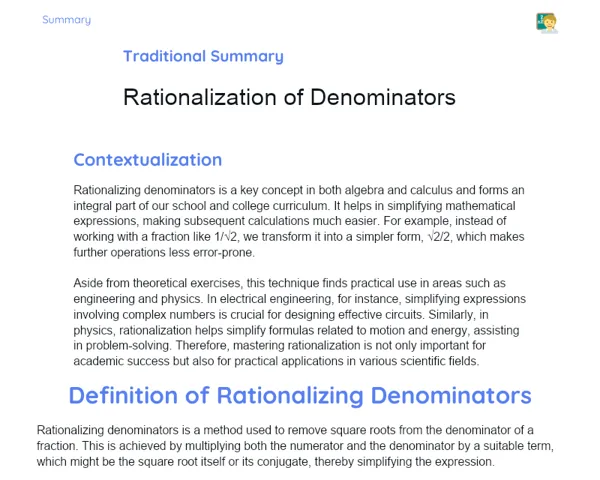Goals
1. Calculate the volume of a cylinder using the correct formula.
2. Determine the surface area of a cylinder for real-life applications.
3. Connect the concepts of volume and surface area to everyday scenarios.
4. Enhance your practical and experimental problem-solving skills.
Contextualization
Cylinders can be found in many aspects of our daily lives, from everyday items like soft drink cans to larger structures like silos for grain storage. It’s important to know how to compute the volume and surface area of these objects in various professions, be it engineering, architecture, or product design. Accurate calculations help professionals make correct measurements and use materials wisely, ultimately saving time and resources. For instance, civil engineers rely on volume calculations for designing water tanks, while packaging designers calculate the surface area of cylinders to figure out how much material is needed for labels and packaging.
Subject Relevance
To Remember!
Cylinder Volume
The volume of a cylinder measures the amount of three-dimensional space it occupies. The formula to calculate the volume is V = πr²h, where 'V' stands for volume, 'r' represents the radius of the base circle, and 'h' is the height of the cylinder.
-
The formula V = πr²h is derived from the area of the circular base (A = πr²) multiplied by the height of the cylinder.
-
The volume is expressed in cubic units, like cubic centimeters (cm³) or cubic meters (m³).
-
Understanding volume calculation is critical for applications, such as determining the capacity of cylindrical containers.
Cylinder Surface Area
The surface area of a cylinder measures the total area that covers its surface. The formula to calculate surface area is A = 2πrh + 2πr², where 'A' denotes the area, 'r' is the radius of the base circle, and 'h' is the height of the cylinder.
-
Surface area consists of two parts: the lateral area (2πrh) and the area of the two circular bases (2πr²).
-
Surface area is expressed in square units, such as square centimeters (cm²) or square meters (m²).
-
Knowing the surface area is essential for applications like manufacturing labels and packaging for cylindrical products.
Practical Applications
The concepts of volume and surface area of cylinders have numerous practical applications in various fields, including engineering, architecture, and product design. These applications facilitate the optimization of material usage and guarantee accurate measurements.
-
Civil engineers employ volume calculations to design water tanks and storage silos.
-
Packaging designers calculate surface area to determine the quantity of material required for labels.
-
Architects incorporate these concepts when designing cylindrical structures, ensuring both efficiency and beauty.
Practical Applications
-
Civil Engineering: Design cylindrical water reservoirs to optimize water storage and distribution.
-
Product Design: Create efficient cylindrical packaging that minimizes material use while ensuring protection for the contents.
-
Architecture: Develop cylindrical buildings and structures that blend functionality with aesthetics, such as storage silos and towers.
Key Terms
-
Volume: The amount of three-dimensional space occupied by an object, measured in cubic units.
-
Surface Area: The total measure of the area that covers the surface of an object, expressed in square units.
-
Cylinder: A geometric solid featuring two parallel circular bases and a straight lateral surface connecting them.
Questions for Reflections
-
How can the calculations of volume and surface area of cylinders enhance material efficiency in engineering projects?
-
In which ways can understanding these concepts drive innovation in product and packaging design?
-
What challenges have you encountered when applying mathematical formulas in building a soda can prototype?
Practical Challenge: Designing a Water Reservoir
Leverage the knowledge gained to design a cylindrical water reservoir, calculating its volume and surface area.
Instructions
-
Assume the role of a civil engineer tasked with designing a water reservoir for a small community.
-
Identify the dimensions of the reservoir (radius and height) based on the quantity of water to be stored and the available space for construction.
-
Calculate the reservoir’s volume using the formula V = πr²h.
-
Calculate the surface area of the reservoir using the formula A = 2πrh + 2πr².
-
Sketch the reservoir, noting the dimensions and the calculations performed.
-
Compose a brief report explaining your choice of dimensions and how the reservoir will fulfill the needs of the community.



